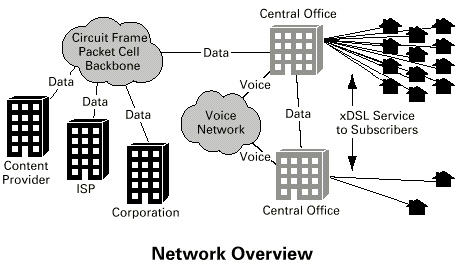
Written and Produced by techguide.com
Sponsored by: PairGain
The accelerated growth of content rich applications which demand high bandwidth has changed the nature of information networks. High speed communication is now an ordinary requirement throughout business, government, academic, and "work-at-home" environments. Internet access, telecommuting, and remote LAN access are three of the clearly defined services that network access providers are offering now. These rapidly growing applications are placing a new level of demand on the telephone infrastructure. In particular, the local loop portion of the network; (i.e., the local connection from the subscriber to the local central office), has become a challenge for telephone companies. Historically, this local loop facility has been provisioned with copper cabling which cannot easily support high bandwidth transmission. This environment is now being stressed by the demand for increasingly higher bandwidth capacities. Although this infrastructure could be replaced by a massive roll-out of fiber technologies, the cost to do so would be insupportable in today's business models and, more importantly, the time to accomplish such a transition is unacceptable because the market demand exists today! Telephone companies are already faced with growing competition and unprecedented customer demands.
A new category of companies, Internet Service Providers (ISPs), has emerged in this market as providers of data services. Traditionally ISPs have used the telephone company infrastructure. However, with the advent of deregulation, they now have direct access to the physical cable plant. ISPs will be formidable competitors in this quest for the customers. This moment is filled with great potential for remarkable success by network service providers around the world.
A new technology called high-speed Digital Subscriber Line (xDSL) has emerged onto this scene. xDSL, which encompasses several different technologies, essentially allows the extension of megabit bandwidth capacities from the service provider central office to the customer premises on a customer by customer basis over the existing copper cabling, without the need for massive infrastructure replacement and at very reasonable costs. These new xDSL solutions satisfy the business need to provision the network in a fast, cost effective manner, while preserving the infrastructure and allowing a planned migration into newer technologies. xDSL has the proven ability to meet the customer demand for high bandwidth right now, at costs that make sense.
It is clear that the telecommunications industry has developed, and deployed, cost effective technologies that have enabled them to create global, high bandwidth, interoffice networks capable of supporting the demands of the information age. This network infrastructure, however, has, until now, been lacking one significant component--a ubiquitous low-cost, high bandwidth access circuit from the customer premises to the local service provider. Called the local loop, this circuit element has been an historic bottleneck, inhibiting customers from taking advantage of the rich array of currently available high bandwidth network services. The pervasive copper cable infrastructure already deployed throughout the local access landscape has, until now, been incapable of supporting the higher bandwidths required by the growing traffic demands of the customer.
In response, the industry has promoted the development of technologies and products that address this need for higher bandwidth solutions in the local loop. The most significant of these developments has been xDSL.
Telephone companies are faced with the perspective of seeing cable TV companies and Competitive Local Exchange Carriers (CLECs), or Competitive Access Providers (CAPs), preparing to go head to head with them for market share. Telephone companies are in an ideal position to capture new customers by offering new, advanced data services on their existing infrastructure of copper telephone lines. Now, their traditional markets are no longer viewed as protected monopolies.
Telephone companies must provide aggressive new services which include voice, video, and high-speed data. These must be packaged, priced, and targeted for markets that have immediate needs and are willing to purchase them. The "end game" here is market share, product differentiation, and product mix. Achieving these results requires rapid deployment, unconstrained by bandwidth limits or deployment barriers.
As a result of the new regulatory realities, telephone companies are experiencing competition from several sources.
New Internet Service Providers (ISPs) are growing rapidly and looking for ways to offer higher bandwidth solutions to their customers. ISPs are in an ideal position to compete with other network service providers due to their data expertise, growing customer bases, and aggressive marketing tactics. With the advent of deregulation, they now have access to the copper wire and are in a position to offer xDSL-based services.
Cable companies, serving a primarily residential base, are exploring new ways to deliver expanded service capabilities to their customers over their existing coaxial cable plant. Competitive access providers, with existing fiber links from businesses to long distance carriers are partnering with these carriers in offering direct competition for local exchange services.

How important is it to expand local access bandwidth now? According to TeleChoice, of Verona, New Jersey, the combined potential revenue from new, broadband based services could exceed $350 billion by the year 2000. The industry and the media have done a great job of setting consumer expectations for advanced data, video, and voice services. xDSL technology enables the existing copper phone network to supply access to these services for rapid market entry and, ultimately, cost-effective universal access.
These high growth directions in the industry are not only the result of technology advancements that satisfy the public's growing demand for high bandwidth, but are being specifically driven by three business and cultural trends.
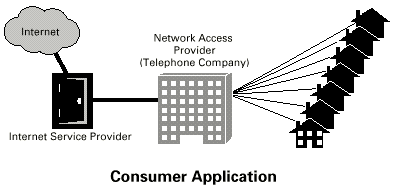
It is readily apparent to young teens, elder seniors, school teachers, and professionals in all fields, that the Internet is where it's happening! Commonly overheard conversations in all sorts of unexpected places are about 28.8 vs. ISDN, web sites, home pages, FTP, chat areas, URLs, E-mail, and more. This occurrence, totally unknown to the casual public just five years ago, has come upon us with the same implacable certainty that pushed televisions into virtually every home in America over a period of ten years from 1950 to 1960. The taste for graphics, sound, live interaction, two way video, and ubiquitous entertainment are already unsatisfied. Demands for better and quicker and richer and prettier, are placing demands on the local telephone infrastructure as nothing ever has in the past! The Internet is certain to be as pervasive as the telephone itself; and the demand for megabit rates bandwidth right to the desktop device is certain.
Network access providers targeting this category will be required to provide low cost, easy to use, higher bandwidth solutions in a highly competitive arena. The new generation of Internet subscribers tends to be non-committed to any particular vendor and will easily change from one ISP to another based on quality of service and cost. The key to quality of service is the fast reliable delivery of high bandwidth. These subscribers also need a relatively high degree of customer support. It represents a perfect opportunity to deploy ADSL technology on a subscriber by subscriber basis, as the demand warrants. ADSL, with it asymmetric bandwidth and stable technology provides exactly the right mix for broad deployment of Internet services.
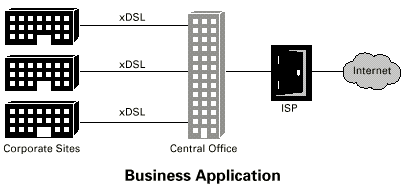
Businesses have had an equally intense preoccupation with the Internet. Businesses are currently formulating plans to use the Internet as an integral part of their networking strategies, with customer and vendor interactions, advanced web site developments, and more. On top of this, is the move towards corporate-wide Intranets. Intranets are internally developed and deployed intra-company networks that operate in essentially the same way as the Internet itself. Major graphic intensive applications, video, sound clips, large scale database deployment, and more, are all becoming mission critical for businesses as they develop revolutionary new business models.
Businesses are also implementing new applications, which, by their very nature, greatly expand the need for bandwidth capacity. These include collaborative processing applications as well as desktop video conferencing, transmitting large graphic files, and real time computing.
Because these new Internet applications present such an exciting opportunity for all types of businesses, Internet Service Providers (ISPs) need to be able to provide highly reliable dedicated circuits in the T1 range. There is a greater need for two way high bandwidth than in the consumer market. Businesses on the Internet anticipate high value and profitability for their investments. Service providers need to deliver security, quality, and cost efficiencies with a high degree of professional customer support to assist their clients in bringing new applications onto the network quickly. The best xDSL solution for these customers is single-pair high-bit-rate digital subscriber line or S-HDSL because of its two way bandwidth capacity and its deployability on single pairs.
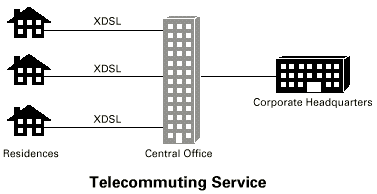
Work-at-home and remote office environments are becoming increasingly attractive to both employers and employees. Quality of life issues, a demand for more normalcy, and a lessening of the stress of today's frenzied existence are becoming important. Business models are based less on the tiered hierarchy of middle management and more on the deployment of workers based on functional areas, communities of interest, and core competencies. Management sees great value in restructuring the virtual work space, unconstrained by the need for physical presence and multi-layered supervision. This leads to highly distributed work environments; some in individual homes, from which a worker "tele-commutes" into core corporate resources. These work-at-home people are connected directly to the corporate network in a way that gives them a virtual presence. To make this happen, there is a need for suitable capabilities in terms of accessibility and bandwidth in the megabit range.
Workers in this environment, as opposed to those needing only Internet access, need high bandwidth in each direction. Whether working in collaborative activities using groupware software applications or moving images or other large files, these people require two way high bandwidth capacity in the megabit range. Simple Internet support is insufficient for this need. Furthermore, because of the mission critical nature of many of these jobs, there is a great need for network reliability. This business model is valuable to employers because of increased job efficiency and flexibility as well as its potential for significant cost reductions. As a result, businesses are quite willing to pay the costs for these home services, since they will operate in a far more cost efficient manner. In these situations, the best xDSL solution is S-HDSL.
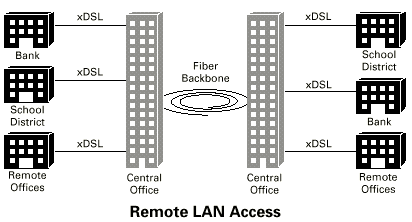
Another aspect of the new business model, in which core competencies are grouped into efficient and self-directing units, is one in which the remote work location consists of a LAN connected over telecommunication services to corporate offices. These remote LAN locations differ from those needing only Internet access in that they require both the transmission and reception of large traffic volumes as they communicate to and from corporate offices. This symmetrical traffic load differs from Internet access which tends to be asymmetrical, with light input and heavy output as large files and graphics are downloaded from Internet services.
In contemporary LAN arrangements, and as opposed to earlier models, 80% of the traffic on the LAN is either from or to remote locations. Even these remote LANs can operate at 10 Mbps, or 16 Mbps or even at 100 Mbps and can not afford to be constrained by a bottleneck in the access part of the network. Unlike telecommuter locations, these remote LAN sites usually have a number of people working together, generating significant volumes of high bandwidth intensive traffic in both directions. Often these sites are engaged in mission critical operations and represent a very high value and profitability to the business. These locations need reliable bandwidth in both directions.
These various telecommuting, Internet access, and remote LAN access applications will require significant bandwidth to meet their service level demands. File sizes of from 30 kbytes to 30 mbytes are commonplace and can not be supported by traditional local loop bandwidth capacities. Corporations have several options involving the acquisition of traditional T1 (~1.5 Mbps) or T3 (~43 Mbps), which are costly but possible for business access. However, when we include small work-at-home telecommuters or individual Internet users, this solution just doesn't work. Telephone company solutions for these customers have thus far been limited to ISDN or analog, voice grade circuits, which when equipped with new 28.8 modems offer some minimally useful capacities. The following chart shows the relative efficiency of these two possibilities compared to various xDSL capacity potentials.
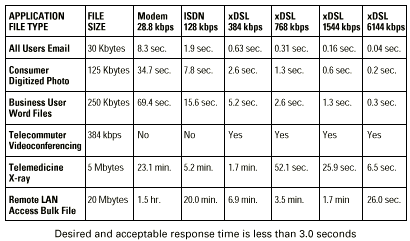
xDSL refers to a set of similar technologies that provide high bandwidth over copper twisted pair local loop cable, without amplifiers or repeaters along the cable route. It refers to the connection between the customer and the first node within the network. xDSL is provided over non-loaded local copper loops1 which are the overwhelming majority of cable facilities in a telephone exchange area.
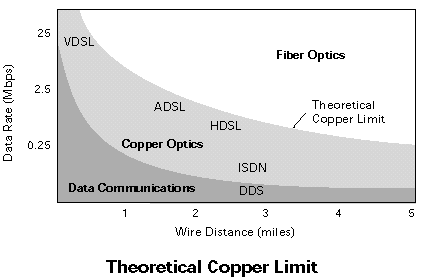
xDSL technology is compatible with existing services, such as POTS (plain old telephone service), ISDN, and DDS, and will work over the majority of copper loops existing today.
xDSL technology supports industry-standard transmission formats and bit rates, such as T1 (1.544 Mbps) and E1 (2.048 Mbps), and is sufficiently flexible to support additional rates and formats as they are defined (e.g., 6 Mbps asymmetric for high speed data and video). xDSL technology coexists in the loop with voice. As a result, all types of services, including the existing voice, video, multimedia, and data services can be carried without developing new payload strategies or standards from scratch. This is critical to seamless deployment of higher bandwidth-based services.
xDSL is a modem-like technology in that it requires an xDSL terminating device at each end of the cable pair which accepts a data stream, usually in digital format, and overlays it onto a high speed analog signal. The three modulating techniques currently in common use for xDSL divide the signal frequency range into three basic elements to carry POTS as well as the upstream and downstream high bandwidth signals. These three modulating schemes are 2B1Q, carrier-less amplitude phase modulation (CAP), and discrete multitone modulation (DMT).
xDSL technology provides symmetric and asymmetric bandwidth configurations to support both one way and two way high bandwidth requirements. We refer to configurations as symmetric if the channel bandwidth needed or provided is the same in both directions. Traditional POTS (plain old telephone service), for example, is a symmetric application (albeit, relatively low-bandwidth in nature).
Asymmetric applications are those in which bandwidth needs are much higher in one direction than the other. For example, browsing the Web requires very little bandwidth from the customer to the video/data source. It requires just enough to pass control information and billing data. This could be kilobits per second (kbps). On the other hand, the required bandwidth in the direction of transmission from the video/data source to the customer is on the order of megabits per second (Mbps).
These are acronyms for various flavors of Digital Subscriber Line technologies. Digital Subscriber Line (DSL), High-bit-rate Digital Subscriber Line (HDSL), Single-pair High-bit-rate Digital Subscriber Line (S-HDSL), Symmetric Digital Subscriber Line (SDSL), Asymmetric Digital Subscriber Line (ADSL), Rate Adaptive Digital Subscriber Line (RADSL) and Very High-bit-rate Digital Subscriber Line (VDSL). These terms refer to the way transmission bandwidth is configured and used to support the customer's bandwidth needs.
Digital Subscriber Line, or DSL, is fundamentally another name for an ISDN-BRI channel operating at the Basic Rate Interface with two 64 kbps circuit switched channels and one 16 kbps packet switching and signaling channel. This circuit can carry both voice and data in both directions at the same time.
xDSL refers to those various arrangements in which advanced modulating techniques are imposed onto the local channel in order to derive higher throughput in one or both directions. The various types of xDSL are described in the following sections.
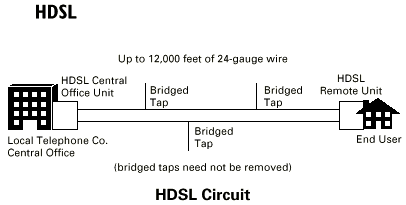
High-bit-rate Digital Subscriber Line (HDSL) derives its name from the high bandwidth that is transmitted in both directions over two copper loops. HDSL has proven to be a reliable and cost effective means for providing repeater-less T1 and E1 services over two twisted pair loops. This proven technology has already resulted in the deployment of over 300,000 HDSL equipped circuits throughout the local access infrastructure. HDSL transceivers can reliably transmit a 2.048 Mbps data signal over two non-loaded, 24 gauge (0.5mm), unconditioned twisted wire pair loops at a distance of up to 13 kft (4.2 km) without the need for repeaters.
Eliminating the need for repeater equipment and removal of bridged taps significantly simplifies the labor and engineering effort to provision the service. This attribute eliminates the need to identify, modify, and verify a controlled environment, with power, secured access, and other factors needed to support repeater equipment. It also reduces the time, cost, and effort of isolating faults and taking corrective action when a failure does occur. Studies by some service providers have indicated that trouble shooting and replacing defective repeater equipment often costs significantly more than the cost of the equipment itself. These attributes translate into increased network up time and reduced engineering time; making possible T1 provisioning in a matter of days, as opposed to weeks. Faster service provisioning and greater up time leads to increased customer satisfaction and increased service revenues. To provision a 12 kft (3.6 km) local loop with traditional T1 transmission equipment, requires two transceivers and two repeaters. To provision the same loop with HDSL, requires only two HDSL transceivers, one at each end of a line.
Single-pair or Symmetric High-bit-rate Digital Subscriber Line (S-HDSL/SDSL) operate on a single copper pair as opposed to the traditional two pair HDSL described above. S-HDSL/SDSL allows easy implementation of applications that require symmetric data rates on a single local loop while maintaining the existing POTS on the same loop. Because only one pair is needed in this arrangement, the capacity of the entire local loop infrastructure is greatly magnified. With this capability, local providers can extract the maximum value from their existing plant, or deploy new capacities both more quickly and at a lower capital expenditure.
This allows for rapid and cost effective deployment of intermediate data rate services. Potential uses for this technology include fractional T1 with a particular advantage in 768 kbps systems, Work-at-home LAN Access, Distance Learning, Internet Access, and Campus or Large Facility LAN to LAN connectivity. Since S-HDSL/SDSL can be implemented with and without POTS and at multiple data rates, it can have different capacity and reach limitations. The next figure shows the reach distances that can be achieved at several discrete data rates.
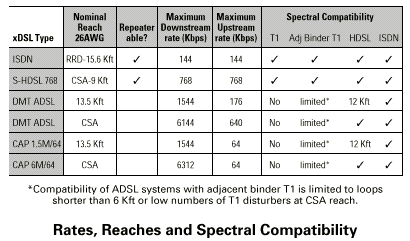
This allows for easy, cost effective implementation of such services as remote cell site support of PCs, remote LAN access, distance education and training, digital imaging, or any other service which requires a larger amount of bandwidth.
Asymmetric Digital Subscriber Line takes its name from the comparatively high bandwidth in one direction, with low bandwidth in the opposite direction. ADSL uses a single phone line for transmission. Many service providers have also come to recognize its potential to support a range of data applications.
Additionally, ADSL's ability to operate at speeds of up to 6 Mbps positions it to support real time broadcast services and pre-recorded interactive video services; and to have multiple video and data activities underway simultaneously. ADSL supports applications with asymmetric traffic demands such as:
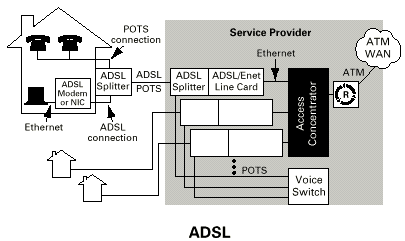
Rate Adaptive Digital Subscriber Line (RADSL) is a simple extension of ADSL used to encompass and support a wide variety of data rates depending on the line's transmission characteristics. This is advantageous in situations in which there is a lower bandwidth demand and in situations in which the line quality is less than needed for full bandwidth implementations.
Very High-bit-rate Digital Subscriber Line (VDSL) provides very high bandwidth asymmetrically (up to 52 Mbps in one direction and 2 Mbps in the other) to businesses and residences with broadband access requirements over a Fiber-To-The-Curb (FTTC) network. Within the FTTC architecture, VDSL will address the last section of copper cabling to the subscriber premises. Typical distance and implementation of VDSL is 1 km @ 26 Mbps.
There are three different modulating techniques presently in use to support xDSL. These are 2B1Q, Discrete Multi-tone modulation (DMT), and Carrierless Amplitude Phase modulation (CAP).
2B1Q represents a straightforward signal type that has 2 bits per baud, arranged as one quaternary, or four level, pulse amplitude modulated scheme. It essentially transmits data at twice the frequency of the signal.
DMT is a newer, multicarrier, technology that divides the three channels into 256 sub-channels onto which traffic is overlaid. This essentially adds a layer of multiplexing to the data stream. It has the benefit of being able to distinguish and isolate subchannels with inferior quality or too much interference and assign traffic to neighboring subchannels instead. This provides a robust approach resulting in high quality and reliability.
Carrierless Amplitude/Phase modulation (CAP) is a proprietary digital modulation technique2. It is relatively low in cost and is based on a mature technology. CAP ADSL, for example, offers 1.5 Mbps downstream with only 64 kbps upstream while DMT-based ADSL offers 6 Mbps downstream and 640 kbps upstream. DMT, in addition, is the official ANSI standard for ADSL.
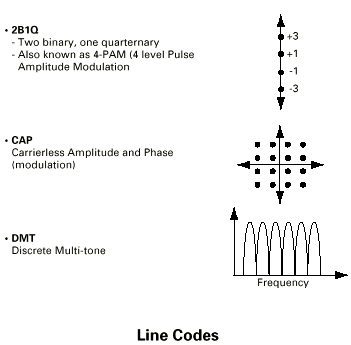
One twisted copper wire pair supports POTS in the 0-4 kHz bandwidth. CAP-based DSL technology uses frequencies sufficiently above the POTS "voice band" to provide bandwidth for low speed upstream and high-speed downstream channels.
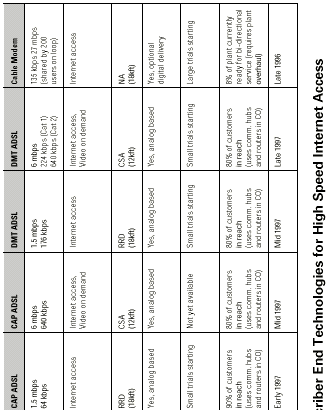
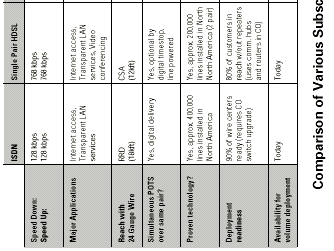
As we consider the need to support the growing demand for Internet access combined with telecommuting and LAN interconnectivity, we can see that xDSL offers the carrier community, internet service provider, and competitive access provider, an amazingly serendipitous opportunity. Faced with the challenge of deploying solutions that meet the growing needs of an expanding market, service providers are quickly coming to the conclusion that xDSL presents them with a remarkably valuable set of options. Because xDSL technologies have matured so quickly and have established a secure, dependable, and broad penetration into the industry, high bandwidth applications can now be supported in a cost effective and competitive basis.
Internet access, telecommuting, and LAN access can be supported as never before. xDSL, being compatible with ISDN and traditional standards such as T1, can be used to deploy those capabilities as well. Given these important and far reaching developments, it is clear that xDSL technologies will be a major component of future service provider infrastructure plans. Using these capabilities, providers can offer a full range of cost effective services, deploy them quickly, and be assured of superb service. xDSL solutions also offer service providers the ability to maximize personnel resources, using existing skills and employees with great efficiency. Consequently, their customers will have a high level of satisfaction and the providers can potentially experience a healthy profit on their investments.
10BASE-T -- The Institute of Electrical and Electronic Engineers (IEEE) 802.3 specification for ethernet over thin coaxial cable.
2B1Q -- 2 binary, one quarternary. A one-dimensional modulation for transmitting 2 bits per symbol. 2B1Q is a 4-level PAM (pulse amplitude modulation) system used for HDSL, S-HDSL, and ISDN BRI.
Access Method -- The method by which networked stations determine when they can transmit data on a shared transmission medium. Also, the software within an SNA processor that controls the flow of information through a network.
Access Provider -- Organization providing and maintaining network services for subscribers.
Access Rate -- The transmission speed, in bits per second, of the physical access circuit between the end user and the network.
Asymmetric Digital Subscriber Line (ADSL) -- A new method of transmitting at speeds up to 7 Mbps in one direction over a single copper telephone line, with up to 640 kbps in the other direction.
ANSI T1.403 -- The performance-monitoring, data-link, and network-interface requirements for ESF CSUs as defined by the Exchange Carriers Standards Association. T1.403 specifies automatic performance reports transmitted to the network once per second via the data link. (In an E1 environment, Performance Monitor is the equivalent of T1.403).
ANSI T1.413 -- The interface standard for DMT ADSL.
Asymmetric Transmission -- Transmission which sends data at different rates in each direction, faster downstream than upstream.
Asynchronous Transfer Mode (ATM) -- The key emerging technology that uses fixed-length packets or cells to switch voice, data and video traffic over the local- and wide-area network.
B Channel -- In ISDN, a full duplex, 64 kbps channel for sending data.
Backbone network -- The main artery or link for a private or public network. Typically the backbone carries the lion's share of traffic (data, voice, video or some combination), is capable of carrying significant bandwidth and it is the network to which small/remote networks/links are attached.
Bandwidth -- A term now used to describe the capacity or amount of traffic (data, voice or video) a certain communications line is capable of accommodating.
Baseband -- Transmission scheme in which the entire bandwidth, or data-carrying capacity, of a medium (such as coaxial cable) is used to carry a single digital pulse, or a signal, between multiple users. Because digital signals are not modulated, only one kind of data can be transmitted at a time. Contrast with broadband.
Basic Encoding Rate (BER) -- Rule for encoding data units described in ANS.1.
Basic Rate Interface (BRI) -- Reference ISDN.
Bit Error Rate (BER) -- The ratio of received bits that are in error.
Bits Per Second (bps) -- The number of bits passing a point every second. The transmission rate for digital information.
Bridge/Router -- A device that can provide the functions of a bridge, router or both concurrently. Bridge/ router can route one or more protocols, such as TCP/IP and/or XNS, and bridge all other traffic.
Broadband -- Data transmission at a high rate, generally greater than T1 speeds (1.5 Mbps). This allows the transmission of voice, data and video signals over a single medium.
Cable modem -- Modem designed for use on TV coaxial cable circuit.
Campus Area Network -- A network which encompasses interconnectivity between floors of a building and/or buildings in a confined geographic area such as a campus or industrial park. Such networks would not require public rights-of-way and operate over fairly short distances.
CAP -- Carrierless Amplitude Phase Modulation. A two-dimensional line code used in ADSL.
Central Office -- A local telephone company office which connects to the main system where circuit switching of customer lines occurs.
Channel -- A communication path. Multiple channels can be multiplexed over a single cable in certain environments. The term is also used to describe the specific path between large computers and attached peripherals.
Channel Service Unit/Data Service Unit (CSU/DSU) -- A digital interface unit that connects end user equipment to the local digital telephone loop.
Churn -- The term used to describe turnover in subscribers of various media such as magazines, newspapers, cable, and videotex services. Churn is an important measure of a medium's success in holding on to customers after they have been signed up as subscribers.
Circuit-Switched Network -- Network that establishes a physical circuit temporarily, until it receives a disconnect signal.
Competitive Access Provider (CAP) or Competitive Local Exchange Carrier (CLEC) -- Alternative provider to Local Exchange Carrier (LEC).
Circuit Switching -- Switching system in which a dedicated physical circuit path must exist between sender and receiver for the duration of the "call". Used heavily in the phone company network, circuit switching often is contrasted with contention and token passing as a channel-access method, and with message switching and packet switching as a switching technique.
Client/Server -- A distributed system model of computing that brings computing power to the desktop, where users ("clients") access resources from servers.
Coder/Decoder (Codec) -- Equipment to convert between analog and digital information format. Also may provide digital information format. Also, may provide digital compression functions.
Common Carrier -- Licensed utility that provides communications services at government-regulated rates.
Compression -- Reducing the size of a data set to lower the bandwidth or space required for transmission or storage.
Concentrator -- Device that serves as a wiring hub in star-topology network. Sometimes refers to a device containing multiple modules of network equipment.
Conditioned Analog Line -- Analog line to which devices have been added to improve the electrical signal.
Consultative Committee for International Telegraph and Telephone (CCITT) -- The former name of an international organization that develops communications standards such as Recommendation X.25. Now called ITU-T.
CopperOptics -- A PairGain trademark referring to the functionality of the company's xDSL technology. In essence, with PairGain xDSL products, users can achieve fiber optic-quality signal transmission over copper cable.
Crosstalk -- Line static that can occur when wire pairs within the same bundles are used for separate signal transmission. Especially evident with repeatered T1/E1 transmission.
Customer Premises Equipment (CPE) -- Terminating equipment, such as terminals, phones, routers and modems, supplied by the phone company, installed at customer sites, and connected to the phone company network.
D Channel -- Full duplex 16 kbps (basic rate) or 64 kbps (primary rate) ISDN channel.
Data Circuit-terminating Equipment (DCE) -- Equipment that resides at the customer end of a transmission link and provides all necessary termination functions for that link. May be owned by the customer or by the service provider.
Data Communications Equipment (EIA expansion) or Data Circuit-Terminating Equipment (CCITT expansion) (DCE) -- The devices and connections of a communications network that connect the communication circuit with the end device (data terminal equipment). A modem can be considered a DCE.
Data Terminal Equipment (DTE) -- The part of a data station that serves as a data source, destination, or both, and that provides for the data communications control function according to protocol. DTE includes computers, protocol translators, and multiplexers.
Dedicated Line -- A transmission circuit installed between two sites of a private network and "open," or available, at all times.
Demodulation -- Opposite of modulation; the process of retrieving data from a modulated carrier wave.
Dial up -- A type of communication that is established by a switched-circuit connection using the telephone network.
Digital Signal 0 (DS-0) -- (1) North American Digital Hierarchy signaling standard for transmission at 64 kbps. (2) Digital Signal Level 0 is the worldwide standard transmission rate (64 kbps) for PCM digitized voice channels. 24 DSOs exist in each DS1 (T1) signal.
Digital Signal 1 (DS-1) -- North American Digital Hierarchy signaling standard for transmission sat 2.544 Mbps. Supports 24 simultaneous DS-O signals. Term often used interchangeably with T-1, although DS-1 signals may be exchanged over other transmission systems.
Digital Subscriber Line (DSL) -- Another name for an ISDN BRI channel. Operated at the Basic Rate Interface (with two 64 kbps circuit switched channels and one 16 kbps packet switched channel), the DSL can carry both voice and data signal at the same time, in both directions, as well as the signaling data used for call information and customer data.
Digital Signal Processing (DSP) -- The processing of signal transmission using digital techniques.
DMT -- Discrete Multitone. In DMT, a large number of low-rate carrier frequencies are QAM-modulated at a low rate to transmit a single high-rate data stream. DMT is used for ADSL and proposed for VDSL.
Drop Cable -- A cable that connects a network device such as a computer to a physical medium such as an Ethernet network. Drop cable is also called transceiver cable because it runs from the network node to a transceiver (a transmit/receiver) attached to the trunk cable.
Echo Cancellation -- Process by which a transmitter/ receiver cancels out the transmitted signal as to "hear" the received signal better.
E1 -- The term for a digital facility used for transmitting data over a telephone network at 2.048 Mbps. The European equivalent of T1.
E3 -- The highest transmission rate generally available in the European digital infrastructure (34 Mbps).
Enterprise Network -- A large typical corporate network under the auspices of one organization.
Ethernet -- A baseband LAN specification invented by Xerox Corporation and developed jointly by Xerox, Intel, and Digital Equipment Corporation. Ethernet networks operate at 10 Mbps using CSMA/CD to run over coaxial cable. Ethernet has become a series of standards produced by IEEE referred to as IEEE 802.3.
Fiber Optics -- A method for the transmission of information (sound, pictures, data). Light is modulated and transmitted over high purity, hair-thin fibers of glass. The bandwidth capacity of fiber optic cable is much greater than that of conventional cable or copper wire.
Fiber Optic Cable -- A transmission medium that uses glass or plastic fibers, rather than copper wire, to transport data or voice signals. The signal is imposed on the fiber via pulses (modulation) of light from a laser or a light-emitting diode (LED). Because of its high bandwidth and lack of susceptibility to interference, fiber-optic cable is used in long-haul or noisy applications.
Fractional T1 -- A WAN communications service that provides the user with some portion of a T1 circuit which has been divided into 24 separate 64 kbps channels.
Frame Relay -- A streamlined packet switching protocol designed to provide high-speed frame or packet switching with minimal delay and efficient bandwidth usage.
Gigabits Per Second (Gbps) -- 1,000,000,000 bits per second. A measure of transmission speed.
Headend -- The source end of a coaxial cable TV system. Often, the site for signal processing equipment essential to proper functioning of a cable system.
High-bit-rate Digital Subscriber Line (HDSL) -- Designed to be a cost-effective method of delivering T1/E1 line speeds over unconditioned copper cable, without the use of repeaters.
Institute of Electrical and Electronic Engineers (IEEE) -- Professional organization that defines network standards. IEEE LAN standards are the predominant LAN standards today, including protocols similar or virtually equivalent to Ethernet and Token Ring.
Integrated Services Digital Network (ISDN) -- a CCITT networking standard devised to provide end-to-end, simultaneous handling of digitized voice and data traffic on the same link.
Interexchange Carrier (IXC) -- (1) A long-distance telephone company offering circuit-switched, leased-line or packet-switched service or some combination. (2) Any individual, partnership, association, joint-stock company, trust, governmental entity or corporation engaged for hire in interstate or foreign communication by wire or radio, between two or more exchanges.
Interface -- (1) The point at which two systems or pieces of equipment are connected. (2) A connection between two systems or devices. A shared boundary defined by common physical interconnection characteristics, signal characteristics, and meanings of interchanged signals.
ISP -- Internet Service Provider
Intranet -- A private network that uses Internet software and standards.
Kilobits per second (kbps) -- 1,000 bits per second. A measure of transmission speed.
Last mile -- A reference to the local loop, the distance between a local telco office and the subscriber, a distance actually about 0 to 3 miles (0 to 4 kilometers).
Leased Line -- A transmission line reserved by a communications carrier for the private use of a customer.
Lifeline POTS -- A minimal telephone service designed to extend a "lifeline" to the telephone system in case of emergency, particularly when electric power is lost.
Line code -- Any method of converting digital information to analog form for transmission on a telephone line. 2B1Q, DMT, and CAP are all line codes.
Link -- Physical connection between two nodes in a network. It can consist of a data communication circuit or a direct channel (cable) connection. Also an LED signal that indicates connection has been established.
Local Area Network (LAN) -- The means by which a local community of users and workgroups can share information and resources electronically. Many communications protocols are used to accomplish this, the most prevalent of which are Ethernet and Token Ring.
Local Area Transport Area (LATA) -- (1) A geographic area established for the provision and administration of communications service. It encompasses one or more designated exchanges, which are grouped to serve common social, economic and other purposes. (2) Contiguous local exchange areas that include every point served by a LEC within an existing community of interest and that serve as the dividing line for the allocation of assets and liabilities between the IXC and the LEC. (3) A telephone company term that defines a geographic area; sometimes corresponds to an area code.
Local Loop -- Refers to the physical copper pair or loop of wire from Central Office to the subscriber.
Metropolitan Area Network (MAN) -- A data communication network covering the geographic area of a city. Often used by a CAP to carry backbone traffic in their serving area.
Modulation -- Process by which signal characteristics are transformed to represent information. Types of modulation include frequency modulation (FM), where signals of different frequencies represent different data values.
Multiplexer (MUX) -- A technique that enables several data streams to be sent over a single physical line. It is also a function by which one connection from a layer is used to support more than one connection to the next higher layer. (2) A device for combining several channels to be carried by one line or fiber.
Network Interface Card (NIC) -- The circuit board installed in a PC that provides the interface between a communicating PC and the network.
Network Management System (NMS) -- A system responsible for managing at least part of a network. NMSs communicate with agents to help keep track of network statistics and resources.
Open Systems Interconnection (OSI) -- A 7-layer architecture model for communications systems developed by ISO and used as a reference model for most network architectures.
Packet -- (1) A logical grouping of information that includes a header and (usually) user data. (2) Continuous sequence of binary digits of information is switched through the network and an integral unit.
Packet Switched Network -- A network in which data is transmitted in units called packets. The packets can be routed individually over the best available network connection and reassembled to form a complete message at the destination.
Pair gain -- The multiplexing of x phone conversations over a lesser number of physical capacities. "Pair gain" is the number of conversations obtained, divided by the number of wire pairs used by the system.
Permanent Virtual Circuit (PVC) -- A defined virtual link with fixed end-points that are set-up by the network manager. A single virtual path may support multiple PVCs.
POTS -- Plain old telephone service.
Postal, Telegraph and Telephone Company (PTT) -- Generic term for a provider of these services. A governmental agency in many countries.
QAM -- Quadrature Amplified Modulation. A two-dimensional modulation used for ADSL, cable modems and proposed for VDSL. CAP is a special case of QAM. In QAM, a single carrier frequency is modulated in both sine and cosine components.
RADSL -- Rate-Adaptive ADSL. A simple extension of ADSL to encompass a wide variety of data rates depending on the line's transmission capability. RADSL can be either CAP or DMT ADSL.
Regional Bell Operating Companies (RBOC) -- Seven LEC telephone companies created after AT&T divestiture.
Remote LAN Access -- A data communications such as a corporate or campus environment in which the computer networks can be accessed remotely via public telecommunications networks.
Repeater -- An electronic device used to regenerate digital signals and restore signal quality across a certain distance of cable.
SDSL -- Symmetric Digital Subscriber Line.
S-HDSL -- Single pair transmission using HDSL technology, normally 2B1Q.
Simple Network Management Protocol (SNMP) -- A network management standard initially established to allow multi-vendor networking devices to be managed more easily with common management tools.
Spanning Tree -- An algorithm, the original version of which was invented by Digital Equipment Corporation, used to prevent bridging loops by creating a spanning tree. The algorithm is now documented in the IEEE 802.1d specification, although the Digital algorithm and the IEEE 802.1d algorithm are not the same, nor are they compatible.
Switched Virtual Circuit (SVC) -- A virtual link, with variable end-points, established through an ATM network. With an SVC, the user defines the end-points when the call is initiated that are subsequently terminated at the end of the call. With a Permanent Virtual Circuit (PVC), the end-points are predefined by the network manager. A single virtual path may support multiple SVCs.
Symmetric Transmission -- Transmission in which a channel sends and receives data with the same signaling rate.
Synchronous Optical Network (SONET)--A recently emerging networking standard that utilizes fiber optics to create backbone networks, capable of transmitting at extremely high speeds and accommodating gigabit-level bandwidth.
T1 -- Digital transmission facility operating with a nominal bandwidth of 1.544 Mbps. Also known as Digital Signal Level 1 (D1). Composed of 24 DS-0 channels in many cases. The T1 digital transmission system is the primary digital communication system in North America.
T3 -- Digital transmission facility operating at 45 Mbps bandwidth. Composed of 28 DS-1 channels in many cases. Also known as DS-3.
Telecommuter -- Person who performs work at home while linked to the office by means of a telecommunications-equipped computer system.
Transmission Control Protocol/Internet Protocol (TCP/IP) -- A reliable, full duplex, connection-oriented end to end transport protocol running on top of IP.
Transparent LAN Service -- Service offered by a provider that is used to connect LANs at geographically separated sites. "Transparent" means the connection is invisible to the user and typically runs at the same speed as the LANS.
Twisted Pair -- Cable consisting of two 18 to 24 AWG (American Wire Gauge) solid copper strands twisted around each other. The twisting provides a measure of protection from electromagnetic and radio-frequency interference.
VOD -- Video On Demand
Wide Area Network (WAN) -- A network which encompasses interconnectivity between devices over a wide geographic area.
1 "Loading" in telephony parlance refers to the addition of small coils, or inductors, in series with the loop at regular intervals. This technique is used to "flatten" the frequency response of the cable transmission line over the voice band, much like an equalizer in a stereo system. 2 CAP is a derivative of Quadrature Amplitude/Phase Modulation (QAM) which has been widely used in modems for over 20 years. DSL transceivers use an integrated 2-Dimensional 8-State Trellis coding) with Viterbi decoding and Reed-Solomon forward error correction to provide reliable transmission in the presence of line impairments. Adaptive channel equalization is also employed to ensure performance against channel impairments and narrowband interference.
Gerald P. Ryan is the founder of Connections Telecommunications Inc., a Massachusetts-based company specializing in consulting, education and software tools which address Wide Area Network issues. Mr. Ryan has developed and taught numerous courses in network analysis and design for carriers, government agencies and private industry. Connections has provided consulting support in the areas of WAN network design, negotiation with carriers for contract pricing and services, technology acquisition, customized software development for network administration, billing and auditing of telecommunications expenses, project management, and RFP generation. Mr. Ryan is a member of the Networld+Interop program committee.
This book is the property of The Applied Technologies Group, Inc. and is
made available upon these terms and conditions. The Applied Technologies Group,
Inc. reserves all rights herein. Reproduction in whole or in part of this book
is only permitted with the written consent of The Applied Technologies Group,
Inc.. This report shall be treated at all times as a proprietary document for
internal use only. This book may not be duplicated in any way, except in the
form of brief excerpts or quotations for the purpose of review. In addition, the
information contained herein may not be duplicated in other books, databases or
any other medium. Making copies of this book, or any portion for any purpose
other than your own, is a violation of United States Copyright Laws. The
information contained in this report is believed to be reliable but cannot be
guaranteed to be complete or correct.
Copyright © 1998 by The Applied Technologies Group, One
Apple Hill, Suite 216, Natick, MA 01760, Tel: (508) 651-1155, Fax: (508)
651-1171
E-mail: info@techguide.com Web Site:
http://www.techguide.com
| Communications & Networking | Internet Technology | Data Warehousing Document Management | Enterprise Solutions Search | About techguide.com | Sitemap | Feedback | FAQ's | Home Copyright © 1998 The Applied Technologies Group, Inc. All Rights Reserved contact webmaster |